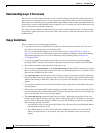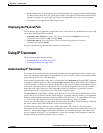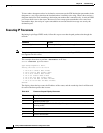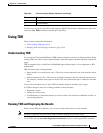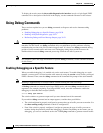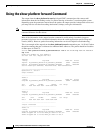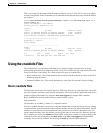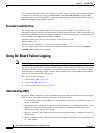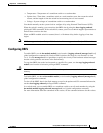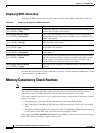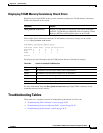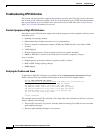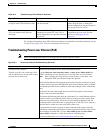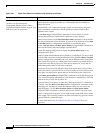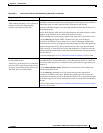
38-24
Catalyst 2960 and 2960-S Switch Software Configuration Guide
OL-8603-09
Chapter 38 Troubleshooting
Using On-Board Failure Logging
You can display the most recent basic crashinfo file (that is, the file with the highest sequence number
at the end of its filename) by entering the show stacks or the show tech-support privileged EXEC
command. You also can access the file by using any command that can copy or display files, such as the
more or the copy privileged EXEC command.
Extended crashinfo Files
The switch creates the extended crashinfo file when the system is failing. The information in the
extended file includes additional information that can help determine the cause of the switch failure. You
provide this information to the Cisco technical support representative by manually accessing the file and
using the more or the copy privileged EXEC command.
Extended crashinfo files are kept in this directory on the flash file system:
flash:/crashinfo_ext/.
The filenames are crashinfo_ext_n where n is a sequence number.
You can configure the switch to not create the extended creashinfo file by using the no exception
crashinfo global configuration command.
Using On-Board Failure Logging
Note OBFL is supported only on Catalyst 2960-S switches running the LAN base image.
You can use the on-board-failure logging (OBFL) feature to collect information about the switch. The
information includes uptime, temperature, and voltage information and helps Cisco technical support
representatives to troubleshoot switch problems. We recommend that you keep OBFL enabled and do
not erase the data stored in the flash memory.
This section has this information:
• Understanding OBFL, page 38-24
• Configuring OBFL, page 38-25
• Displaying OBFL Information, page 38-26
Understanding OBFL
By default, OBFL is enabled. It collects information about the switch and small form-factor pluggable
(SFP) modules. The switch stores this information in the flash memory:
• CLI commands—Record of the OBFL CLI commands that are entered on a standalone switch or a
switch stack member
• Environment data—Unique device identifier (UDI) information for a standalone switch or a stack
member and for all the connected FRU devices: the product identification (PID), the version
identification (VID), and the serial number
• Message—Record of the hardware-related system messages generated by a standalone switch or a
stack member
• Power over Ethernet (PoE)—Record of the power consumption of PoE ports on a standalone switch
or a stack member



